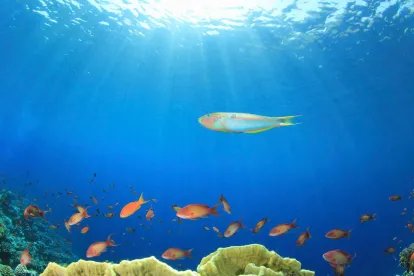On Aug. 3, 2020, a split Fifth Circuit plunged federal aquaculture regulation into murky waters. The United States is a minor aquaculture producer, ranked 17th in 2017 on a global scale – but it is the leading importer of fish and fishery products. According to the National Oceanic and Atmospheric Administration (NOAA), by weight, approximately 90% of the seafood eaten in the United States comes from abroad, over half of it from aquaculture. Part of why the United States has been a minor producer is because domestic aquaculture projects have historically been relegated to state-controlled waters and operations like inland recirculating aquaculture systems. Ocean waters between three and 200 miles offshore are under federal control and have previously been unavailable for farming because of concerns about its effect on wild fisheries and ecosystems. While the United States might be a minor producer, its aquaculture projects are still subject to a complex and evolving regulatory scheme, often navigating permitting and operational requirements imposed by multiple state and federal agencies. With respect to the region at issue in Gulf Fishermens Association et al. v. National Marine Fisheries Service et al., the Gulf of Mexico’s aquaculture currently focuses on stock enhancement, food production, research, and restoration efforts of species including oysters, clams, shrimp, assorted finfish, and algae.
In 1976, the Magnuson-Stevens Fishery Conservation and Management Act (the Magnuson-Stevens Act) was passed in response to overfishing concerns and in an attempt to preserve the nation’s fisheries. In 2009, the Gulf of Mexico Fishery Management Council (comprised of Alabama, Florida, Louisiana, Mississippi, and Texas) created an aquaculture regulatory plan. In 2016, the National Marine Fisheries Service (the NMFS, a division of NOAA) finalized this “comprehensive regulatory plan,” which it claimed was designed to develop an “environmentally sound and economically sustainable aquaculture fishery in Federal waters of the Gulf” (the Final Rule). See 81 Fed Reg. 1762 (Jan. 13, 2016). The Final Rule was the first attempt by the NMFS or any of their eight Regional Fishery Management Councils to regulate aquaculture under the Magnuson-Stevens Act, and the Final Rule would allow for a maximum annual production of 64 million pounds of seafood in the Gulf – equal to the previous average annual yield of all marine species in the Gulf except medhaden and shrimp. Plaintiffs brought suit in 2016, concerned that the Final Rule’s expansion of seafood production would harm traditional fishing grounds, reduce prices of wild fish, subject wild fish to disease, and pollute open waters with chemicals and artificial nutrients.
The Fifth Circuit held that because the Magnuson-Stevens Act “neither says nor suggests that the agency may regulate aquaculture,” the NMFS may not do so. To reach this conclusion, the court applied the two-step test established in Chevron, U.S.A., Inc. v. Nat. Res. Def. Council, Inc., 467 U.S. 837 (1984). Step one of Chevron deference requires courts to ask whether Congress has directly spoken to the precise question at issue and, if the statute is silent or ambiguous, then proceed to step two: questioning whether the agency’s construction is permissible. According to the Fifth Circuit, NMFS failed step one of the test because the Magnuson-Stevens Act “unambiguously precludes the agency from creating an aquaculture regime” and therefore it affirmed the district court’s 2018 ruling that the Final Rule exceeded the agency’s statutory authority and held that “[i]f anyone is to expand the forty-year-old Magnuson-Stevens Act to reach aquaculture for the first time, it must be Congress.” Problematically, Congress has made several attempts to pass offshore aquaculture legislation, including bills in the 109th, 110th, 111th, 112th, and 115th Congress, none of which were enacted. In the 116th Congress, no comprehensive aquaculture legislation has been introduced, though several bills have been introduced that are related to offshore aquaculture and aquaculture generally, including the Keep Finfish Free Act of 2019 (H.R. 2467), the Commercial Fishing and Aquaculture Protection Act of 2019 (S. 2209), the Prevention of Escapement of Genetically Altered Salmon to the United States Act (H.R. 1105) and the Shellfish Aquaculture Improvement Act of 2019 (H.R. 2425).
Further muddying the waters, while the Fifth Circuit appeal was pending, the U.S. Environmental Protection Agency stepped in to issue draft permits under the Clean Water Act to an offshore aquaculture project that, if completed, would be the first in federal waters of the contiguous United States. Then in May 2020, the Trump administration issued an executive order designed to encourage large-scale fish farming. The order included several components, including a provision permitting finfish aquaculture “in marine and coastal waters out to the limit of the territorial sea and in ocean waters beyond the territorial sea within the exclusive economic zone of the United States.” The executive order also designated NOAA as the lead agency for shepherding applications for aquaculture projects in federally controlled waters and the U.S. Army Corps of Engineers as the agency tasked with drafting nationwide permits.
The continued absence of a governance system for regulating offshore aquaculture creates inconsistencies and obstacles to the industry’s development. At present, the aquaculture permitting process is complex and lengthy, creating uncertainty and resulting in challenges for both investment and ongoing operations. Even where states provide regulations, the states’ waters only reach three miles offshore, creating two voids in the current scheme: consistency for U.S. coastal operations and potential to farm beyond the three-mile boundary. Reconciling the executive order with the Fifth Circuit’s decision, not to mention sorting out regulatory responsibilities among states, Regional Fishery Management Councils, and multiple federal agencies, may result in continuing litigation.
For the aquaculture industry these unanswered logistical questions make for increased uncertainty and may make onshore operations an easier option in the short term. Innovative indoor aquaculture operations continue to develop across the United States, and while these operations are still subject to permitting requirements, the regulatory landscape may be more certain than for coastal operations. While scalability for this developing area of AgTech may still present some uncharted territory, until a federal solution settles the waters, offshore aquaculture remains turbulent.




 />i
/>i
